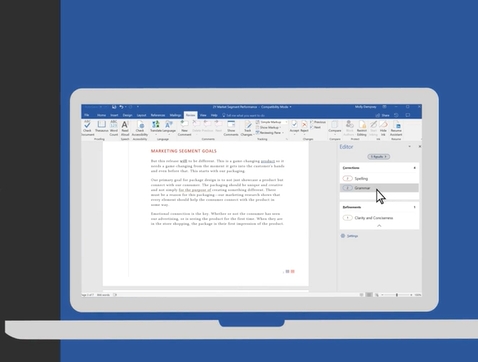Introduction
Good grammar is essential for effective communication in writing. It helps ensure clarity, professionalism, and credibility. Microsoft Word offers powerful grammar tools that can help you identify and correct grammar errors, improving the quality of your documents. In this comprehensive guide, we’ll explore how to use Word’s grammar checking features to their fullest potential.
Enabling Grammar Checking in Word
Before you can take advantage of Word’s grammar tools, you’ll need to enable the grammar checker and customize its settings to suit your preferences.
Turning on the Grammar Checker
- Open Microsoft Wordand navigate to the “File” tab.
- Click on “Options” and then select “Proofing” from the left-hand menu.
- Under the “When correcting spelling and grammar in Word” section, check the boxes next to “Check grammar with spelling” and “Mark grammar errors as you type.”
- Click “OK” to save the changes.
Customizing grammar checking options
Word allows you to customize various grammar checking options to better suit your writing style and preferences. Here’s how:
- Follow the steps above to access the “Proofing” options.
- In the “Writing Style” section, choose your preferred writing style (e.g., Formal, Casual, etc.).
- Expand the “Grammar & Refinements” section and adjust the settings according to your needs. For example, you can choose to ignore specific grammar rules or enable additional refinements.
- Click “OK” to save your customizations.
Understanding Grammar Errors and Suggestions
Word’s grammar checker identifies various types of grammar errors and provides suggestions for improvement.
Types of Grammar Errors
Common grammar errors that Word can detect include:
- Sentence structure errors: Fragmented or run-on sentences, incorrect word order, and more.
- Subject-verb agreement errors: Incorrect subject-verb agreement, such as “the students has completed the assignment.”
- Punctuation errors: Incorrect or missing punctuation marks.
- Spelling errors: Misspelled words or misused homophones (e.g., “their” vs. “there”).
- Style suggestions: Recommendations for improving clarity, conciseness, and overall writing style.
Navigating Grammar Errors and Suggestions
As you type or review your document, Word will underline potential grammar errors with a squiggly line. Here’s how to navigate and address these errors:
- Right-click on the underlined error to see a contextual menu with suggested corrections.
- Select the appropriate suggestion from the list to apply the correction.
- If Word’s suggestion is incorrect or if you want to ignore the error, choose “Ignore” from the contextual menu.
- If a word is underlined but not recognized by Word, you can add it to the dictionary by selecting “Add to Dictionary” from the contextual menu.
Advanced Grammar Checking Techniques
While Word’s basic grammar checking is helpful, there are some advanced techniques that can further enhance your grammar checking experience.
Using Grammar Checker While You Type
Word’s “Check grammar as you type” feature can save you time by catching errors as you write, rather than waiting until after you’ve finished your document.
- To enable this feature, follow the steps in the “Turning on the Grammar Checker” section above, and make sure the “Mark grammar errors as you type” option is checked.
- As you type, Word will underline potential grammar errors with a squiggly line, allowing you to address them immediately.
Checking Grammar in Specific Areas
In addition to checking the entire document, Word allows you to check grammar in specific sections or elements of your document.
- Checking grammar in a selection: Highlight the text you want to check, then right-click and select “Grammar” from the contextual menu.
- Checking grammar in comments: Place your cursor within a comment, right-click, and select “Grammar” from the contextual menu.
- Checking grammar in footnotes and endnotes: Place your cursor within a footnote or endnote, right-click, and select “Grammar” from the contextual menu.
Customizing Grammar Checking Settings
As mentioned earlier, Word allows you to customize various grammar checking settings to better suit your needs.
- Configuring grammar checking language: If you’re writing in a language other than the default, you can change the grammar checking language by going to “File” > “Options” > “Language” and selecting the appropriate language.
- Turning off specific grammar rules: In the “Proofing” options, expand the “Grammar & Refinements” section and uncheck any rules you want to ignore.
- Creating custom grammar rules: Word allows you to create and add your own custom grammar rules by going to “File” > “Options” > “Proofing” > “Settings” > “Grammar Settings” > “User-defined Rules.”
Grammar Checking Limitations
While Word’s grammar tools are powerful, it’s important to understand their limitations. The grammar checker relies on algorithms and may not always account for context or nuance. Additionally, some grammar rules are subjective, and the suggestions may not align with your preferred writing style.
It’s essential to remember that grammar checking is not a substitute for human proofreading. Always review your documents carefully and use your best judgment when accepting or rejecting grammar suggestions.
Additional Grammar Resources
If you need further assistance with grammar or want to improve your writing skills, Word offers additional resources and tools.
Online Writing Resources
- Grammar handbooks and style guides: Refer to trusted grammar handbooks and style guides for comprehensive grammar rules and guidelines.
- Grammar checking websites and tools: Explore online grammar checking websites and tools, which can provide additional suggestions and explanations.
Word’s Other Writing Tools
In addition to the grammar checker, Word offers several other writing tools that can help improve your documents:
- Thesaurus: Access Word’s built-in thesaurus to find alternative word choices and improve your vocabulary.
- Word Count: Use the word count feature to track the length of your document and ensure you meet any specified word count requirements.
- Readability Statistics: Access readability statistics to gauge the complexity and grade level of your writing, allowing you to adjust your style as needed.
Conclusion
Good grammar is essential for clear and effective communication in writing. By utilizing Word’s grammar checking tools and following the techniques outlined in this guide, you can significantly improve the quality and professionalism of your documents.
Remember, while grammar checking is a valuable tool, it should not be relied upon exclusively. Always review your documents carefully and use your best judgment when accepting or rejecting grammar suggestions. Additionally, continue to improve your grammar knowledge by referring to trusted resources and practicing regularly.
With dedication and the right tools, you can master grammar in Word and take your writing to new heights of clarity and polish.








